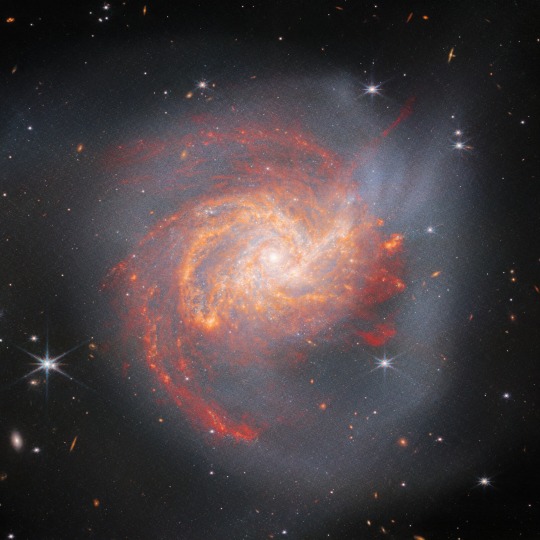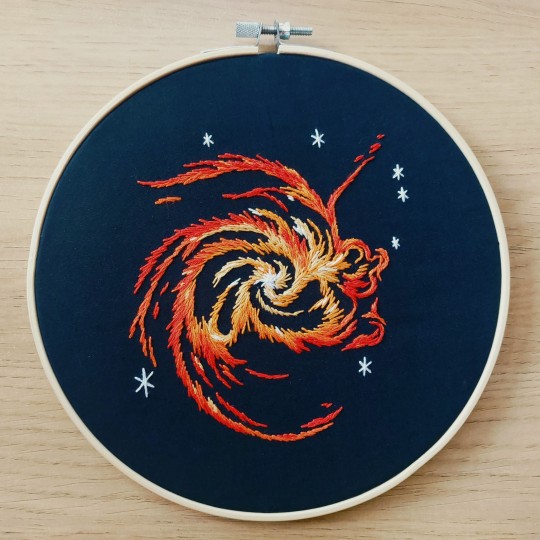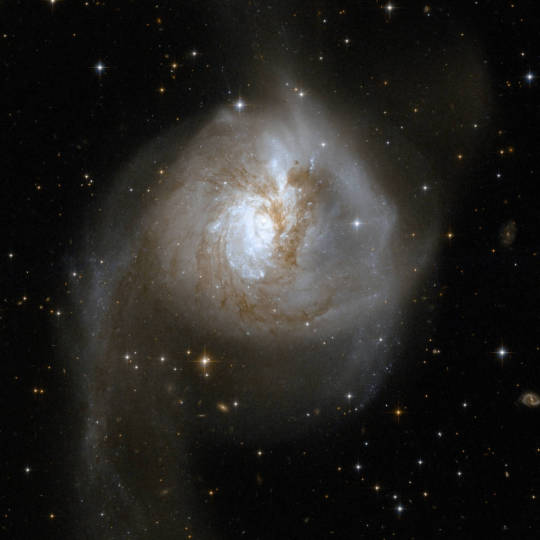#galaxy NGC 3256
Text

Visible Merger
146 notes
·
View notes
Text

galaxy NGC 3256 dominates this image from the NASA/ESA/CSA James Webb Space Telescope. This Milky Way-sized galaxy lies about 120 million light-years away in the constellation Vela, and is a denizen of the Hydra-Centaurus Supercluster.
NGC 3256 may seem peaceful, a swirl of tightly entwined spiral arms set in a hazy cloud of light, but this image shows the aftermath of an ancient cosmic clash. This distorted galaxy is the wreckage of a head-on collision between two equally massive spiral galaxies which astronomers estimate to have met around 500 million years ago. The tumultuous past of NGC 3256 is captured in the long tendrils of shining dust and stars which extend outwards from the main body of the galaxy. The striking red and orange regions spread across the galaxy contain young stars created in the merger that are irradiating small dust grains, which then emit infrared light that is captured in astonishing detail by Webb’s instruments. Further out, there are extended tidal features, which are mostly stars pulled out of the galaxies when they collided.
If you were asked to picture a galaxy collision, you might picture stars careening into one another with catastrophically explosive results. In reality, the spaces between the stars in a galaxy are vast; when galaxies collide, their clouds of stars pass through one another and mingle like two clouds of smoke. The gas and dust in colliding galaxies does interact, however, and with spectacular results. The galactic collision that created NGC 3256 triggered a luminous burst of star formation that can be seen in the brightest portions of this image. These infant stars shine most brightly at infrared wavelengths, light which can penetrate through obscuring dust in the galaxy, and which makes the stars perfect subjects for Webb.
This observation is one of several which take a detailed look at the physics of star formation and black hole growth in nearby merging galaxies, hoping to transform astronomers' understanding of galactic evolution. Capturing a selection of luminous infrared galaxies like NGC 3256 will help the astronomical community to understand how Webb can unravel the complex histories of nearby star-forming galaxies.
This image contains data from Webb’s Near-InfraRed Camera and Mid-InfraRed Instrument, which — as the names suggest — capture NGC 3256 in stunning detail at infrared wavelengths. Previous observations of NGC 3256 with the NASA/ESA Hubble Space Telescope revealed this cosmic collision at visible wavelengths, and Hubble and Webb observations are shown side-by-side using the slider tool here.
[Image Description: A large, face-on spiral galaxy. The core is radiating very brightly. Streaks of dust glow intensely red, in the centre and across most of the galaxy. This gas is surrounded by a dark grey halo made of the galaxy’s stars. The halo stretches out into a tidal tail at the upper-left, and another at the bottom. Small stars and galaxies surround the spiral galaxy, on a black background.]
#galaxy NGC 3256#galaxy#NGC 3256#astronomy#NASA/ESA/CSA#James Webb Space Telescope#universe#space#stars#galaxies#god's creation#gods creation#nature#sky#beauty#love
33 notes
·
View notes
Photo

Galaxies Collide in NGC 3256
Credits: NASA, ESA, Hubble Heritage, STScI, AURA, ESA, UVa, NRAO, SUNYSB
46 notes
·
View notes
Text
Webb Telescope Captures Cosmic Clash of the galaxy NGC 3256 in a new image released on July 3, 2023. Read full article here

30 notes
·
View notes
Text


Clash of the Titans – NGC 3256
A galaxy 120 million light years away in the constellation Vela, as imaged by the James Webb telescope in IR earlier this month (and later rendered in embroidery by yours truly). NGC 3256 formed from the collision of two spiral galaxies half a billion years ago. At its core are two nuclei, which will eventally coalesce as the merger continues. It has two prominent spiral arms and a bright halo of stars which have been distorted into tidal tails by galactic tides.
27 notes
·
View notes
Text
The peculiar galaxy NGC 3256 dominates this image from the NASA/ESA/CSA James Webb Space Telescope. This Milky Way-sized galaxy lies about 120 million light-years away in the constellation Vela, and is a denizen of the Hydra-Centaurus Supercluster. Follow like for article.
5 notes
·
View notes
Text

The peculiar galaxy NGC 3256 dominates this image from the NASA/ESA/CSA James Webb Space Telescope.
0 notes
Text
James Webb Space Telescope captures dazzling galaxy collision
The James Webb Space Telescope has captured an image of a stunning cosmic collision.
The Milky Way-sized galaxy NGC 3256 lies about 120 million light-years away in the constellation Vela.
The European Space Agency and NASA said that it was estimated to have formed 500 million years ago, with the intermingling of dust and gas from the impact of the two massive spiral galaxies that sparked star…

View On WordPress
0 notes
Photo

NGC 3256 - Colliding Galaxies
#ngc3256#Colliding Galaxies#NGC 3256#nasa#stargazing#astrophoto#astrophotography#galaxy#astronomy#universe#space#nebula#spinningblueball#milky way#milky way galaxy#star
68 notes
·
View notes
Photo

Peculiar Galaxy NGC 3256 by NASA Hubble
332 notes
·
View notes
Text

Star Forming Merger
135 notes
·
View notes
Text
The peculiar galaxy NGC 3256 is located approximately 100 million light-years away from Earth in the constellation of Vela and is the result of a past galactic merger, which created its distorted appearance. As such, NGC 3256 provides an ideal target to investigate starbursts that have been triggered by galaxy mergers.
Credit: ESA/Hubble, NASA

#science#news#outer space#astronomy#universo#space science#space exploration#astronomy news#research#space
3 notes
·
View notes
Photo

NGC 3256, Merging Galaxies in Vela
#Astronomy#NASA#Night#Sky#Stars#Space#Science#Universe#Cosmos#Constellations#Constellation#Vela#Galaxies#Galaxy#Nebula#Solar System#Rainbow#Bright
942 notes
·
View notes
Photo

The Clash of NGC 3256: This 500 million year old clash of two separate galaxies spans some 100 thousand light-years in this sharp Hubble view.
141 notes
·
View notes
Link
Now this is most certainly fascinating! It sounds like a great place to go and study close up...if only we could. :(
0 notes
Photo



Top pic: Although the two galaxies in NGC 3256 appear merged when viewed in visible light, a second, bright nucleus is found hiding among the tangle of dust lanes in the central region. By using a range of telescopes on the ground and in space, the GOALS (Great Observatories All-sky LIRG Survey) research team has been analyzing galaxies like NGC 3256 from X-ray through radio wavelengths. NGC 3256 has a buried active nucleus, large-scale shocks from two powerful outflows, and a huge number of compact, bright star clusters. Upcoming research with the James Webb Space Telescope will help researchers learn more about the outflows, which will allow them to better model the hot and cold gas, and determine what implications that has for how and where stars form in rapidly evolving galaxies. Credits: NASA, ESA, the Hubble Heritage (STScI/AURA)-ESA/Hubble Collaboration, and A. Evans (University of Virginia, Charlottesville/NRAO/Stony Brook University)
2nd pic: Since the galaxies that make up NGC 7469 are both almost face-on when viewed from Earth, it's easier to identify the areas where a black hole may exist. A powerful accreting supermassive black hole, surrounded by a ring of young stars, lives at the heart of the galaxy in the upper right. High-resolution infrared imagery from the James Webb Space Telescope is required to determine if the stars form differently around a central supermassive black hole compared to star formation farther out in the galaxy's arms. Webb will also help researchers trace the gas outflows, which will help pinpoint where and how the interstellar medium is affected, which subsequently drives or quenches star formation. Credits: NASA, ESA, the Hubble Heritage (STScI/AURA)-ESA/Hubble Collaboration, and A. Evans (University of Virginia, Charlottesville/NRAO/Stony Brook University)
3rd pic: These merging galaxies, known as II Zw 096, are the site of a spectacular burst of star formation that is hinted at in the red speckles near the middle of the image. This dust-shrouded area conceals a brilliant burst of star formation that becomes more apparent at longer wavelengths of infrared light. The image above combines near-infrared, visible, and far-ultraviolet observations from the Hubble Space Telescope. Researchers using infrared data from NASA's Spitzer Space Telescope estimated the starburst, which lives in a small red region at the center of this image, is cranking out stars at the breakneck pace of around 100 solar masses per year. The upcoming James Webb Space Telescope will allow researchers to penetrate the dust and search for a buried, rapidly growing supermassive black hole. Credits: NASA/JPL-Caltech/STScI/H. Inami (SSC/Caltech)
NASA's Webb Will Explore the Cores of Merging Galaxies
When galaxies collide, it's as if all the players in a symphony have begun a furious crescendo: As their stars and gas fall toward the center, star formation escalates. At the same time, the galaxies' black holes engorge themselves and light up, releasing energy and material into the surrounding gas. These "overtures," which continue for hundreds of millions of years, are brightest where the centers of galaxies – called nuclei – merge, and those areas are also filled with dust. Until now, high-resolution infrared observations from space that can pierce through the dust weren't possible. NASA's James Webb Space Telescope's observations will return both infrared imagery and spectra that will allow researchers to add incredible detail to our understanding of the precise mechanics at work.
A research team led by Lee Armus of the California Institute of Technology/IPAC in Pasadena and Aaron Evans of the University of Virginia and the National Radio Astronomy Observatory in Charlottesville will study the centers of a class of interacting galaxies known as merging luminous infrared galaxies. "Webb's instruments will provide huge leaps in our abilities to resolve what is happening in these galaxies," explained Armus. "The images and spectra will not only be 50 to 100 times more sensitive than previous infrared data, but also significantly sharper."
These merging galaxies are often gas-rich spiral galaxies, which means they are still forming stars before colliding. As they approach one another and conduct a delicate "dance," gas in the galaxies loses angular momentum and funnels toward the center. This triggers additional star formation at an accelerated rate, up to hundreds of solar masses per year compared to one or two per year observed in normal star-forming galaxies like our own. While stars are forming, they heat the surrounding dust, generating enormous amounts of energy in infrared light.
Webb's high-resolution, infrared instruments will allow researchers to resolve the central star-forming regions for the first time. "We are aiming to observe areas as small as 150 to 300 light-years across," said Evans. "For context, these galaxies span hundreds of millions of light-years across. Webb will strip away all the dust and see the activity that’s at their cores."
Further reading and video: https://www.nasa.gov/feature/goddard/2020/nasas-webb-will-explore-the-cores-of-merging-galaxies/?utm_source=FBPAGE&utm_medium=NASA%27s+James+Webb+Space+Telescope&utm_campaign=NASASocial&linkId=105640096&fbclid=IwAR03Q6RBchd22YP5KatSfSnaqxCiyOIU9YSpK1ulhUKCszwP1tuMgfR_nIs
7 notes
·
View notes